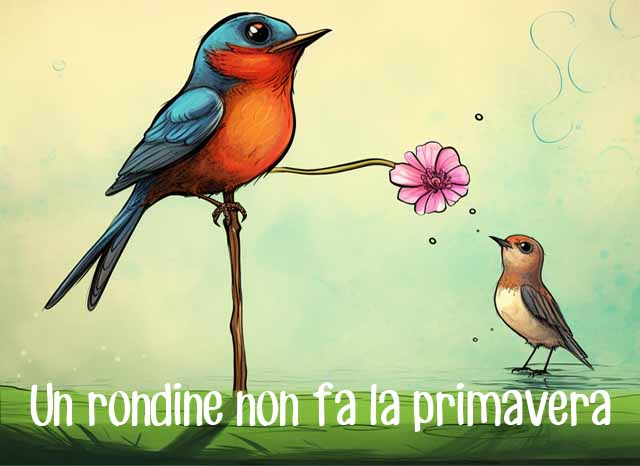
Era ora! Tira fuori il tuo spolverino grammaticale e chiariamo alcuni dubbi sul congiuntivo. Penso che sia una costruzione meravigliosa da imparare. Mi piace particolarmente il congiuntivo perché puoi esprimere i tuoi pensieri, opinioni e desideri con questo modo verbale. Puoi davvero far sapere alle persone cosa ne pensi!
It’s time! Get out your feather grammar duster, and let’s clean up some doubts about the subjunctive tense. I think it is a wonderful construction to learn. I’m particularly fond of the subjunctive mood because this verb construction lets you express your thoughts, opinions, and desires. You can really let people know what you think!

Alcuni dicono che il congiuntivo è un po’ “spaventoso”, e ne sono un po’ terrorizzati!
Some say the subjunctive tense is a bit “scary”,
and they are a bit terrified of it!
Ma niente paura gente! Il congiuntivo è il modo più elegante della lingua italiana. Quando lo impari, migliorerai notevolmente il tuo livello di italiano e sembrerai più un madrelingua.
But have no fear, people! The subjunctive tense is the most elegant mood in the Italian language. When you learn it, you will significantly improve your level of Italian, and you will sound more like a native speaker.

Oggi ho deciso di parlare del congiuntivo perché Laura, una delle mie studentesse di conversazione settimanale, sta lavorando duramente per inchiodare questo tempo nella sua testa. Il mio consiglio a lei e a tutti voi è che prima è fondamentale concentrarsi sul congiuntivo presente, familiarizzare come vengono coniugati i verbi e imparare ad identificare le situazioni in cui è necessario il congiuntivo.
I’ve decided to highlight the subjunctive mood today because Laura, one of my weekly conversation students, is working hard to nail this tense. My advice to her and to all of you is, first, it is crucial to concentrate on the present subjunctive tense get familiar with how verbs are conjugated, and learn to identify situations in which the subjunctive is necessary.
Bene! Cominciamo con una semplice
spiegazione del Congiuntivo Presente.
Great! So let’s begin with a simple
over view of the Congiuntivo Presente.
Innanzitutto, devi imparare come i verbi si coniugano al congiuntivo. Non è davvero difficile imparare a coniugare i verbi al congiuntivo. Credimi, sono molto più facili dei verbi remoti del passato che sono così irregolari da farmi girare la testa. Invece, i verbi congiuntivi rientrano praticamente in questi schemi:
First, you need to learn how verbs conjugate in the Subjunctive tense. It’s really not difficult to learn how to conjugate subjunctive verbs. Believe me, they are way easier than the passato remote verbs that are so irregular they make my head spin. Instead, subjunctive verbs pretty much fall into these patterns:
Come coniugare i verbi
“-are”, “-ere”. “-ire”
in Congiuntivo Presente
How to conjugate “-are” , “-ere”, and “-ire” verbs
in Subjunctive Presente
Esempi: Present -are verbs
1st, 2nd, 3rd person singular: -i
First-person plural: -iamo
Second person plural: -iate
Third person plural: -ino
Amare
Che io ami
Che tu ami
Che lui/lei ami
Che noi amiamo
Che voi amiate
Che loro amino
Parlare
Che io parli
Che tu parli
Che lui/lei parli
Che noi parliamo
Che voi parliate
Che loro parlino
Esempi: Present -ere verbs
1st, 2nd, 3rd person singular: -a
First-person plural: -iamo
Second person plural: -iate
Third person plural: -ano
Credere
Che io creda
Che tu creda
Che lui/lei creda
Che noi crediamo
Che voi crediate
Che loro credano
Ricevere
Che io riceva
Che tu riceva
Che lui/lei riceva
Che noi riceviamo
Che voi riceviate
Che loro ricevano
Esempi: Present -ire verbs
1st, 2nd, 3rd person singular: -a
First-person plural: -iamo
Second person plural: -iate
Third person plural: -ano
Sentire
Che io senta
Che tu senta
Che lui/lei senta
Che noi sentiamo
Che voi sentiate
Che loro sentano
Dormire
Che io dorma
Che tu dorma
Che lui/lei dorma
Che noi dormiamo
Che voi dormiate
Che loro dormano
How to conjugate Irregular verbs (there are a few)
Essere (to be) and Avere (to have)
Essere
Che io sia
Che tu sia
Che lui/lei sia
Che noi siamo
Che voi siate
Che loro siano
Avere
Che io abbia
Che tu abbia
Che lui/lei abbia
Che noi abbiamo
Che voi abbiate
Che loro abbiano
Note: 1) the first, second, and third persons singular are identical. 2) Verbs ending in -care and -gare insert an h between the stem and the endings: dimentichi, dimentichiamo, dimentichiate, dimentichino; paghi, paghiamo, paghiate, paghino
Come riconoscere quando usare il congiuntivo presente
How to recognize when to use the Congiuntivo Presente tense.
Indicativo vs. Congiuntivo
L’indicativo afferma un fatto o una certezza: so qualcosa per certo, qualcosa è un fatto, qualcosa che è oggettivamente reale.
The Indicative Mood states a fact or a certainty — I know something for sure, something is a fact, something that is objectively real.
Lui è una persona intelligente.
So che l’acqua è inquinate.
Oggi è un bel giorno.
State bene insieme.
Leonard da Vinci è un genio.
A differenza dell’inglese, il congiuntivo è molto comune sia nel parlare che nello scrivere in italiano. Si usa nelle clausole dipendenti introdotte da che, quando i soggetti della proposizione principale e della proposizione dipendente sono diversi.
Unlike in English, the Subjunctive is very common in both speaking and writing in Italian. It is used in dependent clauses introduced by che, when the subjects of the main clause and the dependent clause are different.
Quando la clausola introduttiva esprime possibilità, desiderio, paura, dubbio e opinione personale, saprai usare il tempo soggettivo.
Per esempio:
When the introductory clause expresses possibility,
wish, fear, doubt, and personal opinion, you will know
to use the subjective tense. For example:
Credo che…
Ho paura che…
Immagino che…
Mi sembra che…
Non sono sicuro che…
Penso che…
Suppongo che…
Apsetta che…
Bisogna che…
Mi dispiace che…
Mi fa piacere che…
Preferisco che…
Voglio che…
È importante che…
È probabile che…
È possibile che…
È facile che…
Mettiamo tutto insieme adesso. Facciamo riferimento alle nostre frasi originali che affermavano fatti e trasformiamole in frasi che esprimono opinioni, dubbi, credenze o incertezze.
Let’s put this all together now. Let’s refer back to our original sentences that stated facts and turn them into sentences that express opinions, doubt, beliefs, or uncertainty.
Lui È una persona intelligente.
= Indicative tense
Penso che lui SIA una persona intelligente.
= Subjunctive mood.
Penso che [main clause expresses a belief]
+ che
+ lui SIA una brava persona [dependent clause requires subjunctive verb.]
So che l’acqua è inquinate. Indicative Tense
Ho paura che l’acqua sia inquinate. Subjuntive Tense
Oggi è un bel giorno. Indicative Tense
Mia mamma pensa che oggi sia un bel giorno. Subjuntive Tense
State bene insieme. Indicative Tense
Mio padre non è sicuro che voi due stiate bene insieme. Subjuntive Tense
Leonard da Vinci è un genio. Indicative Tense
Mi sembra che Leonard da Vinci sia un genio. Subjuntive Tense
Attenzione: usiamo questa struttura
del congiuntivo solo quando abbiamo DUE soggetti diversi; quando il soggetto è
lo stesso si usa Di + infinito.
Attention: We use this subjunctive structure only
when we have TWO different subjects; when
the subject is the same; we use Di + infinitive
Il soggetto è lo stesso nella prima e nella seconda frase negli esempi seguenti.
The subject is the same in the first and second clauses in the following examples.
Io penso di essere sincera.
Tu credi di arrivare domani.
Marta vuole di mangiare qualcosa.
Se fossero soggetti diversi sarebbero coniugati nel soggettivo in questo modo:
If they were different subjects they would be conjugated in the subjective like this:
Io credo che Marco sia sincere.
(I’m the subject of the first clause, Marco is the subject of the second)
Tu credi che la mamma arrivi domani.
Marta vuole che Angela mangi.

Ripassiamo / Let’s Review
The subjunctive mood expresses possibility, wish, fear, doubt, and personal opinion.
It is often used in dependent clauses with verbs expressing a personal opinion: “Io penso che tu sia un genio.”
The word “che” can not be omitted.
This structure is used when the two clauses have different subjects.
If the subject is the same in both clauses, then the structure is completely different; It’s not che + subjunctive but di + infinitive.
The difference between Indicative and Congiuntivo is knowing a fact and expressing opinion or uncertainty: Ho saputo che domani ARRIVA lo zio. vs. Spero che domani ARRIVI lo zio.
Aggiungiamo qualche altra cosa al tuo “piatto” congiuntivo presente “da masticare.”
Let’s add a few more things to your
congiuntivo present “plate”to chew on.
The subjunctive can be used in independent clauses to express a doubt, a wish, an appeal, or an exclamation:
Tenga pure il resto!
Viva Italia!
It can be used to express a polite request:
Signora, entri pure!
Prego, signora, venga pure!
Si accomodi!
It can be used ironically:
Marco non vuole prestarmi la sua macchina.
Ma non mi importa: che se la tenga!
Elisa non vuole stare qui con noi.
Ah si`? E allora che se ne vada!
Bene! Questo è una un quadro generale della situazione. Del congiuntivo presente. Spero che questa lezione sia utile a quelli di voi che stanno lavorando duramente per capirla.
And that is a brief overview of the Subjuntive Present tense. I hope this lesson is helpful to those of you who are working hard to understand it.
Ma aspetta! C’è più. Il congiuntivo viene non solo al tempo presente. Infatti! Ha QUATTRO tempi! Presente, imperfetto, perfetto e piuccheperfetto.
But wait! There’s more. The Congiuntivo comes not only in the present tense. Indeed! It has FOUR tenses! Present, Imperfect, Perfect, and Pluperfect.

Allacciate le cinture
e restate sintonizzati!
Buckle up your seatbelts and stay tuned!
Vi lascio digerire questo post sul congiuntivo presente. Impara a coniugare i verbi -are, -ere e -ire al congiuntivo presente.
I’ll let y’all digest this post on the present subjunctive. Master how to conjugate -are, -ere, and -ire verbs into present subjunctive.
E poi, seguirò questo post con uno che esaminerà il congiuntivo nel passato e le strutture imperfette. Sono tempi succosi che usano -assi, essi e issi!
And then, I’ll follow up this post with one that will review the subjunctive in the past and imperfect structures. They are juicy tenses that use -assi, essi and issi!
Sbirciata: Volevi che io parlassi dell’imperfetto del congiuntivo! Grande! Penso che sia un buon’idea!
(Sneak peek: You wanted me to talk about the imperfect of the subjunctive! Great! I think it’s a good idea!)
Fammi sapere se hai domande! Alla prossima!











